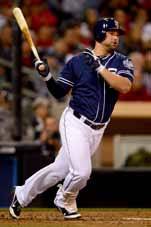As Summer Sizzles, Watch for Signs of Heat-Related Illnesses

Padres first baseman Yonder Alonso says he keeps a close eye on the weather forecast and starts drinking plenty of water the day before extreme heat is expected.
Ever wonder how hot a baseball field can get in the summer?
Padres first baseman Yonder Alonso remembers a game in Alabama where the heat from his metal spikes burned through to the skin of his feet.
Outfielder Carlos Quentin says he nearly fainted in the batter’s box during a long at bat in Kansas City. And pitcher Andrew Cashner recalls seeing heat waves shimmer up from the turf in Texas.
Summertime in San Diego is less intense by comparison. But August and September are the county’s two hottest months, and exposure to extreme high temperatures can take a potentially deadly toll.
Heat-related illnesses occur when people are exposed to severe temperatures and the body is unable to cool down. These illnesses are often spurred by physical exertion and dehydration. Those at greatest risk include infants, young children, adults 65 and older and people with physical or mental illnesses.
The best defense is prevention. Drink plenty of (nonalcoholic) fluids, stay in a cool place indoors and wear lightweight clothing. Also, keep close tabs on those at higher risk.
Following are symptoms of key heat-related illnesses, along with steps to take if they develop.
Heat Stroke.
This is the most serious heat-related illness. Warning signs vary but may include a body temperature above 103 degrees, nausea, confusion, headache, a rapid pulse, and skin that’s red, hot and dry. Death or permanent disability can result. Call for immediate medical assistance, get the victim to a shady area and cool by any means possible. If medical response is delayed, call a hospital emergency department for instructions.
Heat Exhaustion.
This can develop after several days in high temperatures with inadequate replacement of fluids. Warning signs include heavy sweating, fatigue, dizziness, cool and moist skin, and fast and shallow breathing. If untreated, heat exhaustion may progress to heat stroke. To cool the body, drink fluids, take a cool shower or bath and rest. Seek medical attention if symptoms persist beyond an hour.
Heat Cramps.
These muscle pains or spasms usually arise in the abdomen, arms or legs during or after strenuous activity. Heat cramps often stem from profuse sweating, which depletes the body’s salt and moisture. When cramps occur, stop activity and find a cool place to sit quietly. Avoid strenuous activity for a few hours after cramps subside. Those with heart problems or on low-sodium diets should seek medical attention for heat cramps.
Media Contact
- Steve Carpowich
- 858-312-0328
- carpowich.stephen@scrippshealth.org
- Follow me: @Carpowich